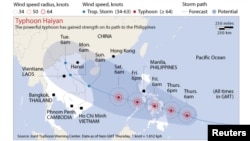MANILA —
The Philippines is bracing for the world's strongest storm so far this year that is expected to make landfall in the central part of the country Friday. Evacuations and preparations are underway ahead of Super Typhoon Haiyan.
On state television, forecasters warned that Typhoon Haiyan, which is locally called Yolanda, would pack winds topping 240 kilometers per hour. And this would make it the most powerful storm this rainy season.
Forecasters expect Haiyan to make landfall Friday morning on the eastern-most island province Samar. They say Metropolitan Manila to the northwest will also be under a major storm warning as the typhoon makes its way toward the western part of the country.
The head of the civil defense office says preemptive measures have been going on throughout the central provinces since Tuesday. Undersecretary Eduardo del Rosario says local governments there ordered residents to evacuate and had farmers harvest their crops and secure their livestock before leaving.
He says officials suspended school in the area starting Thursday, while emergency workers got food and medical supplies ready in areas expected to be most affected. Trees were trimmed to minimize damage to power lines, while power was turned off in some parts. The government designated certain schools evacuation sites.
The Coast Guard suspended ferry service and ordered fishing boats to dock.
Philippine army troops were bringing food packs and other relief goods into remote areas.
In the past, emergency management officials had lamented the public’s lukewarm response to heed storm warnings. At the same time, the information was slow to reach people. But after being battered with powerful storms in recent successive years, Del Rosario says this time around the public is ready to follow orders.
“I think with our past experiences, it has taught us a lesson and following the advice of those in government is one of the best things to do,” he said.
Forecasters are comparing this storm to Typhoon Usagi, which slammed the northernmost Philippines in September with winds topping 205 kilometers per hour.
The country experiences an average of 20 major storms per year. And forecasters have said late season storms are a recent development. Haiyan is storm number 24 this year.
Late last year, Typhoon Bopha wreaked havoc in the southeastern Philippines- an area not prone to typhoons- killing more than 1,100 when it tore off roofs of houses and even evacuation sites, and reduced hundreds of hectares of banana trees to piles of splinters and twigs.
In 2011, Tropical Storm Washi caused devastating floods also in a part of the south unused to major storms, killing more than 1,200.
On state television, forecasters warned that Typhoon Haiyan, which is locally called Yolanda, would pack winds topping 240 kilometers per hour. And this would make it the most powerful storm this rainy season.
Forecasters expect Haiyan to make landfall Friday morning on the eastern-most island province Samar. They say Metropolitan Manila to the northwest will also be under a major storm warning as the typhoon makes its way toward the western part of the country.
The head of the civil defense office says preemptive measures have been going on throughout the central provinces since Tuesday. Undersecretary Eduardo del Rosario says local governments there ordered residents to evacuate and had farmers harvest their crops and secure their livestock before leaving.
He says officials suspended school in the area starting Thursday, while emergency workers got food and medical supplies ready in areas expected to be most affected. Trees were trimmed to minimize damage to power lines, while power was turned off in some parts. The government designated certain schools evacuation sites.
The Coast Guard suspended ferry service and ordered fishing boats to dock.
Philippine army troops were bringing food packs and other relief goods into remote areas.
In the past, emergency management officials had lamented the public’s lukewarm response to heed storm warnings. At the same time, the information was slow to reach people. But after being battered with powerful storms in recent successive years, Del Rosario says this time around the public is ready to follow orders.
“I think with our past experiences, it has taught us a lesson and following the advice of those in government is one of the best things to do,” he said.
Forecasters are comparing this storm to Typhoon Usagi, which slammed the northernmost Philippines in September with winds topping 205 kilometers per hour.
The country experiences an average of 20 major storms per year. And forecasters have said late season storms are a recent development. Haiyan is storm number 24 this year.
Late last year, Typhoon Bopha wreaked havoc in the southeastern Philippines- an area not prone to typhoons- killing more than 1,100 when it tore off roofs of houses and even evacuation sites, and reduced hundreds of hectares of banana trees to piles of splinters and twigs.
In 2011, Tropical Storm Washi caused devastating floods also in a part of the south unused to major storms, killing more than 1,200.









